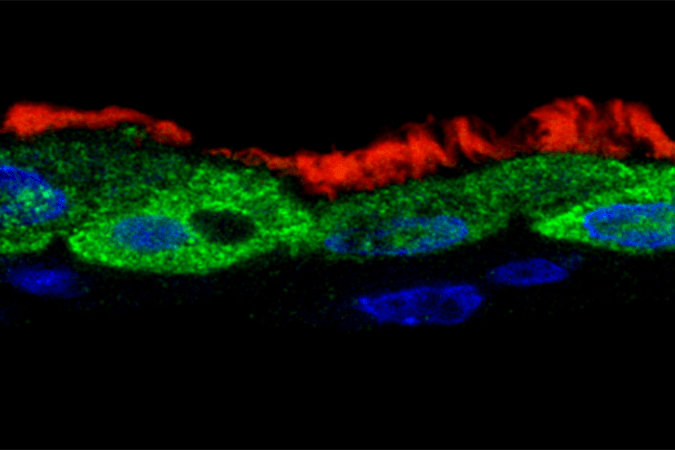Be it the common cold or the flu, it is highly likely that most people are bound to be infected with respiratory infections multiple times. And most individuals recover easily as well. The same holds true for the Respiratory syncytial virus (RSV). However, it can be fatal in children and older adults, and result in hospitalization. Now, scientists have discovered that a protein produced by the virus manipulates immune genes within cells and sabotages immune responses.
In a new study, researchers have discovered that a protein produced by RSV known as nonstructural protein 1 (NS1) can impede the immune defenses of the body. It does so by sneaking inside the nucleus of cells, altering the activity of their immune genes, and disrupting their immune responses. The findings were published in the journal Cell Reports.
"NS1 is an important part of the reason RSV is capable of causing disease. Not only does the protein interfere with the immune response, it is also important for viral replication. I think the work that we describe in this paper provides a basis for targeting NS1 therapeutically or for vaccine development," said Dr. Daisy W. Leung, co-senior author of the study, in a statement.
Lethal In Children and Elderly

Respiratory syncytial virus (RSV) is a contagious negative-strand RNA virus belonging to a family of viruses known as Pneumoviridae. It causes infections of the respiratory tract in humans. Other viruses in this family such as the human metapneumovirus (HMPV) also cause respiratory infections. The mode of transmission of RSV is the same as most respiratory viruses: through contact with droplets from infected individuals.
RSV infection is fairly common with the likeliness of contracting it multiple times. While most people recover from it in a matter of few weeks, it can be fatal in infants and children (infected for the first time), and older adults (in whom immunity to the pathogen has waned). According to the WHO, RSV is one of the leading causes of hospitalizations on account of acute lower respiratory infections, particularly among infants and children, across the world.
The pathogen is one of the most common causes of bronchiolitis (inflammation of the small airways within the lung) and pneumonia (infection of the lungs) in children and older adults. Children who beat severe cases of the RSV are 30 to 40 percent more likely to develop recurrent asthma or wheezing than the general population. The management of the sickness is largely symptomatic. However, antivirals and vaccines against RSV are in different stages of testing across the world.
Determining Manipulation Mechanism
![Scanning electron micrograph of human respiratory syncytial virus (RSV) virions (colorized blue) and labeled with anti-RSV F protein/gold antibodies (colorized yellow) shedding from the surface of human lung epithelial A549 cells [Representational Picture] RSV](https://data1.ibtimes.co.in/en/full/766337/rsv.jpg?h=450&l=50&t=40)
Prior to the current research, scientists studying RSV had already zeroed in NS1 as one of the tools utilized by the virus to counteract the body's immune defenses. In fact, Dr. Leung had published a study in 2017 where she identified the specific section of the protein that was associated with the weakening of immune responses. However, the mechanism employed by the protein to undermine the body's responses remained unclear.
In order to ascertain this process, infected cells from the respiratory tract of an individual with RSV were obtained. Next, an antibody developed by the team against NS1—to track the protein inside cells—was used. This led to a crucial discovery. While RSV's genome and other viral proteins remained within the primary area of the cell and manufactured copies of the pathogen, NS1 crept into the nucleus.
Additional experiments led to the uncovering of what exactly NS1 was carrying out inside the nucleus: disrupting the antiviral actions of the cell by modifying its immune genes' expression. "NS1 wasn't just floating around the nucleus, it was interacting with the proteins that regulate gene expression," stated Dr. Jacqueline E. Payton, co-senior author of the study.

She explained: "The group of genes most affected were the immune-response genes whose expression gets turned on really high when a cell is infected by a virus. It was binding right at the spots on the genome that control expression – the same ones that you'd expect if it were trying to interfere with the immune response."
Potential for Drug Development
The findings of the study offer vital insights that can aid vaccine and drug development. Understanding NS1's manipulation of gene expression of cells can enable the precise targeting of the protein. Additionally, it may also shed more light on the link between RSV and asthma.
Dr. Payton posited that the answer may lie within the epigenome, the pattern of chemical compounds attached to DNA that can modify gene expression. "Once a cell — any cell, not just an immune cell — encounters an infection, its epigenome changes and primes it to be able to respond more quickly the next time it encounters an infection," she illustrated.
Expounding the idea, Dr. Payton concluded: "My theory is that NS1 may alter the epigenome in susceptible patients such that the next time they encounter RSV — or maybe even just dust or cat dander — they have an aberrant inflammatory response that is damaging rather than protective. That is an idea we are exploring now."
















